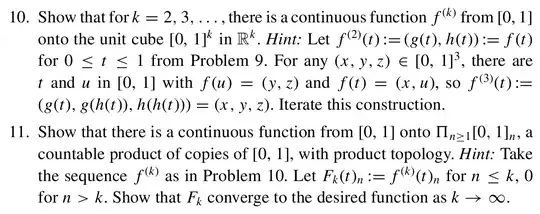I only have difficulties in problem 11.
My efforts:
Follow the hint. We have a sequence of functions {$F_k(t)$}. Each $F_k(t)$ maps $t\in$ [0, 1] to a sequence $(t_1,t_2,...)$ in $\Pi_{n\geq 1}[0,1]_n$. In problem 10, we have constructed a continuous function $f^{(k)}(t)$ from [0, 1] onto $[0, 1]^k$. Now we make reference to a result from a previously solved problem.

Let $X=[0,1]^k$ and $Y=\Pi_{n>k}[0,1]_n$. Let $y_0$ be the all-zero sequence in $Y$. Then the map $f:X\rightarrow X\times Y$ defined by $f(x)=x\times y_0$ is continuous. Then $F_k(t)$ is the composite of two continuous functions: $F_k(t)=f(f^{(k)}(t))$. This holds for each fixed $k$. Thus each $F_k(t)$ is continuous. Of course it is not onto due to its 0-tail.
Recall that $[0, 1]^k$ is using the square metric on $\mathbb{R}^k$: $d_k(x,y)=$ max{$|x_1-y_1|,|x_2-y_2|,...,|x_k-y_k|$}. Also recall that $\mathcal{C}(I,I^k)$ is using the corresponding sup metric: $\rho_k(f,g)=$ sup{$d_k(f(t),g(t))|t\in I$}.
Now $\Pi_{n\geq 1}[0,1]_n$ is using product topology. We cannot treat it as a metric space. Accordingly there is no metric for $F_k(t)$. We cannot write something like $\rho(F_7,F_9)$. We cannot prove the convergence of {$F_k(t)$} by saying it is Cauchy. We can only use the open-neighborhood definition of convergence for {$F_k(t)$}. What's the open neighborhood of $F_k(t)$? We can view $F_k(t)$ as a point in the product space $[0,1]\times\Pi_{n\geq 1}[0,1]_n=\Pi_{n\geq 0}[0,1]_n$. Then the convergence of {$F_k(t)$} to $F(t)$ is defined as: Any open neighborhood of $F(t)$ intersects {$F_k(t)$}. More exactly, it is defined as: Given any $n$ and any $\epsilon>0$, {($x,y$)|max{$|x-t|,d_n(y_{1:n},F(t)_{1:n})$}<$\epsilon$} intersects {$F_k(t)$}. That is, given any $n$ and any $\epsilon>0$, there exists $k$ such that $|t-s|<\epsilon$ and $d_n(F_k(s),F(t))<\epsilon$. The convergence cannot be guaranteed by the construction of $f^{(k)}(t)$. We can find a $F_k(s)$ having the same 1-to-$n$ coordinates as F(t), but $|t-s|$ may be greater than $\epsilon$.
------------------------Updated according to the hints given by Brian M. Scott------------------------
Let $h^{(k)}(t)$ be the $k$-time composition of $h(t)$, e.g., $h^{(3)}(t)=h(h(h(t)))$.
$f^{(2)}(t)=(g(t),h(t))$
$f^{(3)}(t)=(g(t),g(h(t)),h(h(t)))$
$f^{(4)}(t)=(g(t),g(h(t)),g(h^{(2)}(t)),h^{3}(t))$
$f^{(5)}(t)=(g(t),g(h(t)),g(h^{(2)}(t)),g(h^{(3)}(t)),h^{4}(t))$
Given $n$, $t_n^{(k)}=0$ for $k<n$. We claim that $t_n^{(k)}=g(h^{(n-1)}(t))$ for $k>n$. We show this by induction on $n$.
By construction, $f^{(k+1)}(t)=(g(t),f^{(k)}(h(t)))=(g(t),g(h(t)),f^{(k-1)}(h^2(t)))=(g(t),g(h(t)),g(h^{(2)}(t)),f^{(k-2)}(h^3(t)))=...$
The $n=1$ case is that $t_1^{(k)}=g(t)$. This is obvious from the construction.
Assume it is true for all $n$. By construction, $t^{(k)}_{n+1}=h(t)^{(k)}_n=g(h^{(n-1)}(h(t)))=g(h^{(n)}(t))$.
We have shown that $t_n^{(k)}$ is constant after $k>n$.
Next we show $F$ is continuous. We only need to show: Given any open neighborhood $U$ of $\langle t_n:n\geq 1\rangle$, $F^{-1}(U)$ is open.
Since $\prod_{n\geq 1}[0,1]_n$ is using product topology, we can take $U$ to be $$U=\prod^N_{n=1}\big((t_n-\epsilon_n,t_n+\epsilon_n)\cap [0,1]_n\big)\times\prod_{n\geq N+1}[0,1]_n$$ for any fixed $N$. Since $f^{(N)}$ is continuous when $[0,1]^N$ is using square metric topology and the ball $$B(\langle t_n,n=1,...,N\rangle,\min\{\epsilon_1,\ldots,\epsilon_N\}, d_N)\subset\prod^N_{n=1}\big((t_n-\epsilon_n,t_n+\epsilon_n)\cap [0,1]_n\big)\;,$$ $f^{(N)}$ is also continuous when $[0,1]^N$ is using box topology. Thus $F^{-1}(U)=(f^{(N)})^{-1}\left(\prod^N_{n=1}\big((t_n-\epsilon_n,t_n+\epsilon_n)\cap [0,1]_n\big)\right)$ is open.
Finally we need to show $F$ is surjective: Given any $\langle t_n,n\geq 1\rangle\in\prod_{n\geq 1}[0,1]_n$, there exists a $t\in[0,1]$ such that $F(t)=\langle t_n,n\geq 1\rangle$. For any fixed $N$, we can find a $t$ such that $g(h^{(n-1)}(t))=t_n$ for all $n<N$ by construction of $F(t)$. Since $t$ and $t_n$ remain constant as we increase $N$, we have found the desired $t$.

\langle($\langle$) and\rangle($\rangle$); the max and min operators are\max($\max$) and\min($\min$); and the product symbol is\prod($\prod$), just as the summation symbol is\sum($\sum$). – Brian M. Scott Jul 11 '20 at 23:35